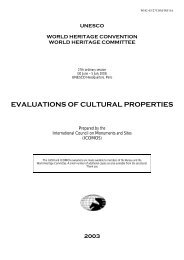IUCN Evaluation of Nominations of Natural and Mixed Properties to ...
IUCN Evaluation of Nominations of Natural and Mixed Properties to ...
IUCN Evaluation of Nominations of Natural and Mixed Properties to ...
Create successful ePaper yourself
Turn your PDF publications into a flip-book with our unique Google optimized e-Paper software.
In carrying out the Technical Review, <strong>IUCN</strong> is guided by the Operational Guidelines, which requests<br />
<strong>IUCN</strong> "<strong>to</strong> be as strict as possible" in evaluating new nominations. The evaluation process (shown in<br />
Figure 1) involves five steps:<br />
1. Data Assembly. A st<strong>and</strong>ardised data sheet is compiled on the site, using the protected area<br />
database at UNEP-WCMC;<br />
2. External Review. The nomination is sent <strong>to</strong> experts knowledgeable about the site, primarily<br />
consisting <strong>of</strong> members <strong>of</strong> <strong>IUCN</strong> specialist commissions <strong>and</strong> networks <strong>and</strong> contacts from the<br />
region (approx. 85 outside reviewers provided input in relation <strong>to</strong> the sites reviewed in<br />
2002/2003);<br />
3. Field Inspection. Missions are sent <strong>to</strong> evaluate the site on the ground <strong>and</strong> <strong>to</strong> discuss the<br />
nomination with relevant authorities <strong>and</strong> stakeholders;<br />
4. <strong>IUCN</strong> World Heritage Operational Panel Review. The <strong>IUCN</strong> World Heritage Operational<br />
Panel intensively reviews all field inspection reports, comments from reviewers <strong>and</strong> associated<br />
background material, <strong>and</strong> agrees a final text <strong>and</strong> recommendation for each nomination;<br />
5. Final Recommendations . After the World Heritage Bureau has reviewed the evaluations,<br />
clarifications are <strong>of</strong>ten sought. Changes based on the Bureau's recommendations <strong>and</strong> on any<br />
further information from State Parties will be incorporated in<strong>to</strong> the final <strong>IUCN</strong> evaluation report<br />
which is sent <strong>to</strong> the World Heritage Centre eight weeks prior <strong>to</strong> the Committee meeting.<br />
In the evaluations, the Biogeographic Province concept is used for comparison <strong>of</strong> nominations with<br />
other similar sites. This method makes comparisons <strong>of</strong> natural sites more objective <strong>and</strong> provides a<br />
practical means <strong>of</strong> assessing similarity. At the same time, World Heritage sites are expected <strong>to</strong> contain<br />
special features, habitats <strong>and</strong> faunistic or floristic peculiarities that can also be compared on a broader<br />
biome basis.<br />
It is stressed that the Biogeographical Province concept is used as a basis for comparison only <strong>and</strong><br />
does not imply that World Heritage sites are <strong>to</strong> be selected solely on this criteria. The guiding principle<br />
is that World Heritage sites are only those areas <strong>of</strong> outst<strong>and</strong>ing universal value.<br />
Finally, it is noted that the evaluation process is aided by the publication <strong>of</strong> some 20 reference volumes<br />
on the world's protected areas published by <strong>IUCN</strong>, UNEP-WCMC <strong>and</strong> several other publishers.<br />
These include (1) Reviews <strong>of</strong> Protected Area Systems in Oceania, Africa, <strong>and</strong> Asia; (2) the four<br />
volume direc<strong>to</strong>ry <strong>of</strong> Protected Areas <strong>of</strong> the World; (3) the three volume direc<strong>to</strong>ry <strong>of</strong> Coral Reefs <strong>of</strong> the<br />
World; (4) the six volume Conservation Atlas series; (5) The four volume “A Global Representative<br />
System <strong>of</strong> Marine Protected Areas; <strong>and</strong> (6) Centres <strong>of</strong> Plant Diversity. These documents <strong>to</strong>gether<br />
provide system-wide overviews which allow comparison <strong>of</strong> the conservation importance <strong>of</strong> protected<br />
areas throughout the world.<br />
As in previous years, this report is a group product <strong>to</strong> which a vast number <strong>of</strong> people have contributed.<br />
Acknowledgements for advice received are due <strong>to</strong> the external evalua<strong>to</strong>rs <strong>and</strong> reviewers <strong>and</strong><br />
numerous <strong>IUCN</strong> staff at Headquarters <strong>and</strong> in the field. Many others contributed inputs during site<br />
inspections. This support is acknowledged with deep gratitude.<br />
This report presents the <strong>of</strong>ficial position <strong>of</strong> <strong>IUCN</strong>.<br />
iv






